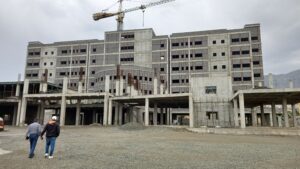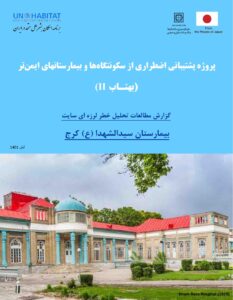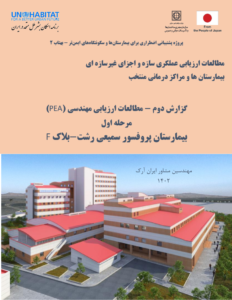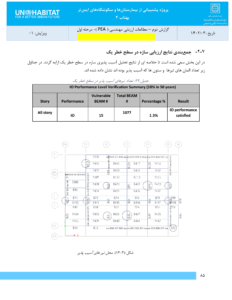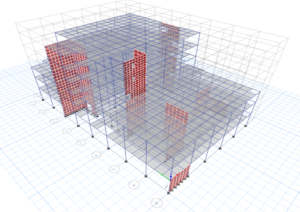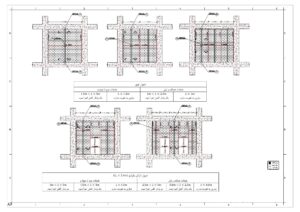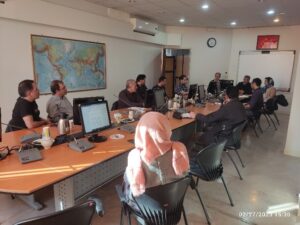Component 1: Multi-hazard Assessment, Vulnerability Analysis, and preparing the retrofit design for existing healthcare facilities
The latest post-disaster observations indicate that, even many Hospitals and Critical Urban Facilities which have been well-designed based on traditional regulations, have shown vulnerable, did not perform satisfactorily during the natural hazards and failed in continuation of providing services during crisis period.
Thus, as a major element of Disaster Risk Reduction and Management (DRRM), the objective of Component 1 in BEHTAB phase II project is shedding light on the vulnerability of existing Risk and provide the detailed knowledge about the vulnerability of the hospitals as critical facility inventory in urban areas against natural hazards. The Project also aims at Instructions for action on Risk Reduction and improving the resilience of the facilities through retrofit design for the vulnerable hospitals, upgrading the design methods for new hospitals, Development of designing retrofit methods for existing facilities.
Meanwhile the considering the resilience of the hospitals against earthquakes, the performance of the facility during the earthquake and continuation of the functions after the event has been taken as a major factor, resulting in the Performance-Based Design (PBD) approach identified as the best for the Project regarding the newly designed and building facilities vs. the traditional force-based methods which has been practiced in the expert communities before implementing this Project.
The Approach to the above Objectives is through a cooperation between UN-Habitat and EOGPBI for studies on vulnerability assessment and retrofit design for existing/under-construction public hospital facilities.
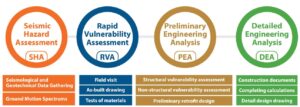
The Project was implemented in three steps for each hospital as:
Rapid Visual Assessment (RVA)More
At the first stage of the studies various site visits were done by UN-HABITAT office and EOGPBI to select the appropriate hospitals for more detailed studies in the BEHTAB phase II Project. The final Target hospitals were selected based on number of beneficiaries, the progress of design and construction of each project and spatial distribution in the country. Afterward more detailed investigations were done by consultants of the project through the RVA on selected target hospitals. RVA Studies included but not limited to providing as-built and design drawings for both structural and non-structural components, material test results, site geotechnical condition and test data as well as progress report for each section of constructions. Results of the RVA studies were then used in the PEA and DEA stages of the seismic assessment studies and documented through RVA Reports.
See More Hospitals Site Visits in BEHTAB-II Gallery
Probabilistic Seismic Hazard Analysis (PSHA) More
In the firs step after selection of the target hospitals for assessment studies, seismic hazard studies were performed for each site considering national and international regulations as well as BEHTAB guideline. Seismic hazard analyses were based on traditional probabilistic approach and expected ground motion intensities of the site are estimated for the anticipated earthquake levels in the region. Ground motions Intensities are reported through acceleration spectrums for different levels of occurrence probability in the lifespan of the Hospitals. Seismic Hazard Studies were done in UN-HABITAT office and supervised and confirmed by an accredited academic expert.
Read the Methodology of Seismic Hazard Studies in BEHTAB-II Publications.
Preliminary Engineering Analysis (PEA) More
PEA studies were the second step of the desk studies in BEHTAB phase II. In this step, target Hospitals’ performance were quantitatively assessed against the probable levels of seismic hazard with respect to the BEHTAB guideline. Assessments were done based on Performance Based Design (PBD) approach by utilizing well-established national (Code 360) and International (ASCE41-17) codes. Acceptable Performance in Anticipated Hazard levels for Hospitals were selected through discussions in the Technical Working Group of the BEHTAB Phase II Project (TWG). The Technical Working Group of the BEHTAB Phase II Project consisted of 8 senior academic experts in the field of structural and earthquake engineering in the country. Assessments were performed for both Structural and Non-Structural (Infill Walls, Mechanical, Electrical and Power Systems) components of hospitals. Vulnerable Structural and Non-structural components of the target Hospitals are identified through PEA results and are documented by PEA Reports.
Detailed Engineering Analysis (DEA) More
After determining vulnerable components of the Hospitals in the PEA stage, appropriate retrofitting solutions are proposed trough more detailed analyses in the DEA step. The retrofitting solution is suggested among different methods by comparing technical, economic and feasibility issues of their construction. Results of the DEA stage are presented in the form of calculation notes, construction drawings and cost estimates for the proposed retrofitting solution.
RVA, PEA and DEA studies were carried out by EOGPBI consultants in the field of hospital design and under the supervision of TWG members through review of reports and meetings with consultants. In this regard multiple sessions were held with consultants for presentation of their studies procedure and results to the TWG members as well as questions and ambiguities through question and answer sessions.
See More Meetings and Technical Sessions in BEHTAB-II Gallery
The main outputs of this component can be addressed as:
- Determining the status of vulnerability of hospitals against natural hazards along with the need for retrofitting and detail design of retrofit methods for each facility of the 11 hospitals (with a capacity of over 4000 beds)
- Knowledge sharing and capacity development in the partners (both public and private sectors) on DRRM and PBD for the public assets
- Develop the institutional and expert required capacity for this transition.



